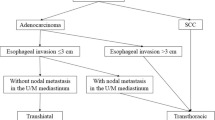Abstract
The surgical results of transthoracic en bloc esophagectomy and high intrathoracic esophagogastrostomy performed on 109 consecutive patients are presented. Adenocarcinoma was present in 59 patients, squamous cell carcinoma in 45 patients, and other neoplastic lesions of the esophagus in 5 patients: 29.5% of the patients received neoadjuvant radiochemotherapy or chemotherapy alone. In 35% of the patients, the preoperative risk was classified as normal, whereas in 42% and 23% of the patients the preoperative status was compromised or severely impaired, respectively. On average 33 lymph nodes were dissected from each specimen. The postoperative course was uneventful in 60% of the patients and prolonged or severe in 40% of the patients. The hospital mortality was 5.5% (six patients). Nine patients (8.2%) developed anastomotic leakage.Six of these nine patients were discharged after rethoracotomy and reanastomosis (n=3) or endoscopic treatment with fibrin glue (n=3).Three patients died despite rethoracotomy and reanastomosis. Only 2 of 103 discharged patients (1.9%) underwent postoperative endoscopic bougienage two or three times because of an anastomotic stenosis. High intrathoracic esophagogastrostomy is a safe anastomosis, which nevertheless requires diligent postoperative management.
Zusammenfassung
An einer konsekutiven Serie von 109 Patienten mit Ösophaguskarzinom (59 Adenokarzinome, 45 Plattenepithelkarzinome, 5 andere Malignome) werden die Ergebnisse der standardisierten transthorakalen En-bloc-Ösophagektomie und hoch intrathorakalen Ösophagogastrostomie analysiert. Mit Radiochemotherapie oder Chemotherapie waren 29,5% der Patienten vorbehandelt worden; 35% der Patienten hatten in der präoperativen Risikoanalyse ein normales, 42% ein mittleres und 23% ein hohes Risiko. Im Mittel wurden 33 Lymphknoten pro Patient entfernt. Der postoperative Verlauf von 60% der Patienten war normal, während 40% einen protrahierten bzw. schweren Verlauf hatten. Insgesamt verstarben 6 Patienten postoperativ entsprechend einer Hospitalmortalität von 5,5%. Anastomoseninsuffizienzen traten bei 9 Patienten (8,2%) auf, von denen 3 nach Reanastomosierung und 3 nach endoskopischer Fibrinklebung ausheilten, während 3 Patienten trotz Rethorakotomie verstarben. Nur 2 von 103 entlassenen Patienten (1,9%) mussten im weiteren Verlauf wegen einer Anastomosenstenose 2- bis 3-mal endoskopisch bougiert werden. Die hoch intrathorakale Ösophagogastrostomie ist eine sichere Anastomose, die jedoch ein konsequentes postoperatives Management erfordert.
Similar content being viewed by others

Author information
Authors and Affiliations
Corresponding author
Rights and permissions
About this article
Cite this article
Hölscher, A.H., Schröder, ., Bollschweiler, E. et al. Wie sicher ist die hoch intrathorakale Ösophagogastrostomie?. Chirurg 74, 726– 733 (2003). https://doi.org/10.1007/s00104-003-0649-z
Issue Date:
DOI: https://doi.org/10.1007/s00104-003-0649-z



